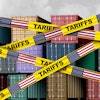
AmCham China and AmCham Shanghai released the results of two joint surveys conducted in collaboration with PwC China (PwC), detailing the supply chain impacts of recent events on U.S. companies operating in China. The overwhelming majority of the surveyed companies have had a presence in China for at least a decade and have widespread operations nationwide.
The first survey, which was conducted in October 2019 and comprised 70 companies, shows that 90% of U.S. companies’ supply chains were affected by the US-China trade dispute, mainly through diversification of supply base, risk management and cost control. However, the adoption of “in China for China” manufacturing and sourcing strategies has mitigated some of these impacts. Most respondents expected continued healthy commercial relations between the United States and China and looked forward to potential improvements in the regulatory environment as a result of the trade disputes.
The second survey, conducted in March with a subset of 25 companies from the original group, shows a focus on returning to full production after the Coronavirus disease (COVID-19) outbreak, with concerns shifting from factory closures to logistics, and 68% of respondents seeing a return to normal activities in China within the next three months.
Due to the rapid spread of COVID-19 and the ensuing operational constraints, around half of the respondents said they were running below normal capacity, with 68% reporting that demand for products and services was below normal. Logistics-related challenges were the greatest anticipated challenge over the coming month, while resources impacting capacity was the next most critical challenge. In the short term, over 70% of companies say they have no plans yet to relocate production and supply chain operations or sourcing outside of China due to COVID-19. In fact, twice as many (24% vs. 12%) planned to shift sourcing as were planning to shift production. Meanwhile, one in five respondents said they believed that COVID-19 would accelerate the process of economic decoupling.
“In contrast to some global narratives, our China-based data suggests that the majority of our members will not be packing up and leaving China anytime soon,” says Alan Beebe, president of AmCham China. “Of course, certain companies in certain industries may diversify away from China or even expand manufacturing operations in the U.S. given the current climate. But this is a costly, time consuming, and largely irreversible process. It is worth emphasizing that China appears ahead of the global curve when it comes to restarting the economy following months of lockdown, and many of the reasons why companies are in China in the first place still hold true today. As a result, we expect to see companies adopting a ‘China + 1’ strategy as a way to diversify supply chain risks while tapping into China market opportunities.”
“The American business community in China has always been dynamic and resilient,” says Ker Gibbs, president of AmCham Shanghai. “Our survey results show that companies are considering adjustments to their business strategy, but there is no mass exodus as a result of COVID-19. Still, there is no escaping the fact that the current crisis adds a new and unwelcome dimension to the conversation about decoupling. This will be part of the discussion for months to come.”
“The survey results are a reflection of the resourcefulness and flexibility of the American business community in China in recovering from the recent challenges. The views of American executives navigating production recovery in China can give hope and guidance to territories who have yet to begin their transition back to growth,” says Jan Nicholas, consulting partner at PwC China. “As we look at global supply chain footprints across larger U.S. MNCs, while several months ago the focus may have been on China reliance and cost across some sectors, COVID-19 has broadened the spotlight as more territories around the global are impacted – through both supply and demand. This is driving the need for a more holistic analysis of supply chain diversification.”
Conducted last fall, the first survey provides additional, longer term context for supply chain issues experienced by US companies in China. On the cost side, the imposition of tariffs by the United States and China typically increased supply chain costs of U.S. companies, with 47% of respondents seeing increased costs of up to 10%, and an additional 16% seeing cost rises of up to 30%. However, fewer than 20% of the responding companies had begun relocating manufacturing outside of China over the prior two years for the purpose of mitigating the negative impact of increasing tariffs, mostly due to the use of “in China for China” strategies for domestic Chinese demand.
Instead, most U.S. companies are focusing on operational improvements, digital transformation and strategic supply chain transformation. For example, 63% of surveyed companies say they are investing in new technologies to automate manufacturing and improve competitiveness. The survey also lists expected improvements in China’s regulatory environment – once the COVID-19 outbreak is in the past – that would encourage companies to invest more in China.



















